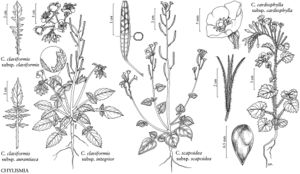Chylismia
Nat. Pflanzenfam. 96[III,7]: 217. 1893.
Herbs,usually annual, sometimes perennial, rarely biennial, usually caulescent. Stems ascending to erect, usually branched. Leaves basal and cauline, cauline often reduced, basal often forming well-developed rosette, alternate; stipules absent; long-petiolate; blade often pinnately (rarely bipinnately) lobed, sometimes unlobed, or lateral lobes greatly reduced or absent, terminal lobe usually large, margins usually regularly or irregularly dentate to serrate, sometimes denticulate, serrulate, or entire, abaxial surface or margin with ± conspicuous, usually brown, oil cells. Inflorescences racemes, erect or nodding. Flowers bisexual, actinomorphic, buds usually erect, sometimes reflexed; floral-tube deciduous (with sepals, petals, and stamens after anthesis), with basal nectary; sepals 4, reflexed singly; petals 4, usually yellow or white, often fading orange-red, sometimes lavender or purple, rarely cream, often with 1+ red dots near base; stamens usually 8, in 2 subequal series, rarely 4 in 1 series (usually in C. exilis), anthers versatile, pollen shed singly or in tetrads; ovary 4-locular, stigma usually entire and capitate, rarely conical-peltate and ± 4-lobed, surface unknown, probably wet and non-papillate. Fruit a capsule, straight or slightly curved, subterete and clavate or oblong-cylindrical, regularly loculicidal; pedicellate. Seeds numerous, in 2 rows per locule, lenticular to narrowly ovoid to narrowly obovoid, finely pitted, with ± pronounced membranous margin when immature. = 7.
Distribution
w United States, nw Mexico
Discussion
Species 16 (16 in the flora).
Chylismia is distinguished from other genera formerly included in Camissonia by straight to arcuate (never twisted or curled) capsules on distinct pedicels and seeds in 2 rows per locule. R. A. Levin et al. (2004) included only one species each from Camissonia sects. Chylismia and Lignothera; the two formed a moderately supported branch, which led W. L. Wagner et al. (2007) to recognize Chylismia as a distinct genus. Chylismia is strongly supported in a sister relationship to the realigned Oenothera. This clade is in turn sister to Eulobus. Reproductive features include: self-incompatible (C. brevipes, C. claviformis, C. multijuga, C. munzii, and probably C. confertiflora, C. eastwoodiae, and C. parryi; P. H. Raven 1962, 1969) or self-compatible; flowers diurnal, outcrossing and pollinated by mostly oligolectic bees or autogamous, or opening one to two hours before sunset (in one subspecies of C. claviformis and the two species of sect. Lignothera); the evening-opening subspecies of C. claviformis pollinated mostly by oligolectic bees and moths, C. cardiophylla mainly by small moths, and C. arenaria, with its long floral tubes, by hawkmoths (E. G. Linsley et al. 1963, 1963b, 1964). Most species are diploid (2n = 14) but there are occasional tetraploids (2n = 28); floating translocations are relatively common (Raven 1962, 1969).
Selected References
None.
Lower Taxa
Key
| 1 | Floral tubes 0.4–9 mm; pollen shed singly; leaves basal and cauline, usually with well-developed basal rosettes, blades usually pinnately or bipinnately lobed, lateral lobes sometimes greatly reduced or absent; plants usually annual, sometimes perennial, rarely biennial. | Chylismia sect. Chylismia |
| 1 | Floral tubes 4.5–40 mm; pollen shed in tetrads; leaves cauline, blades unlobed; plants usually perennial, sometimes annual. | Chylismia sect. Lignothera |
